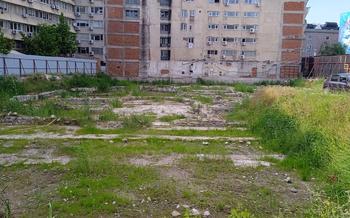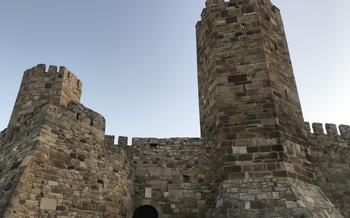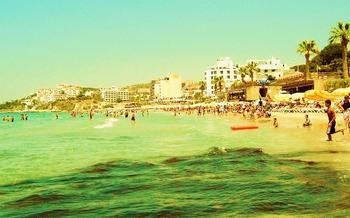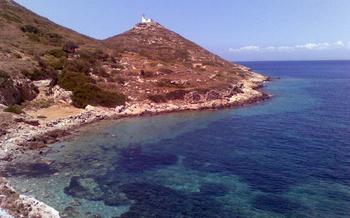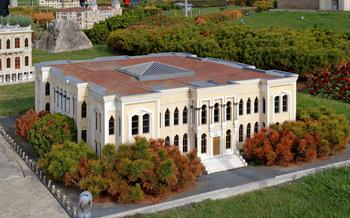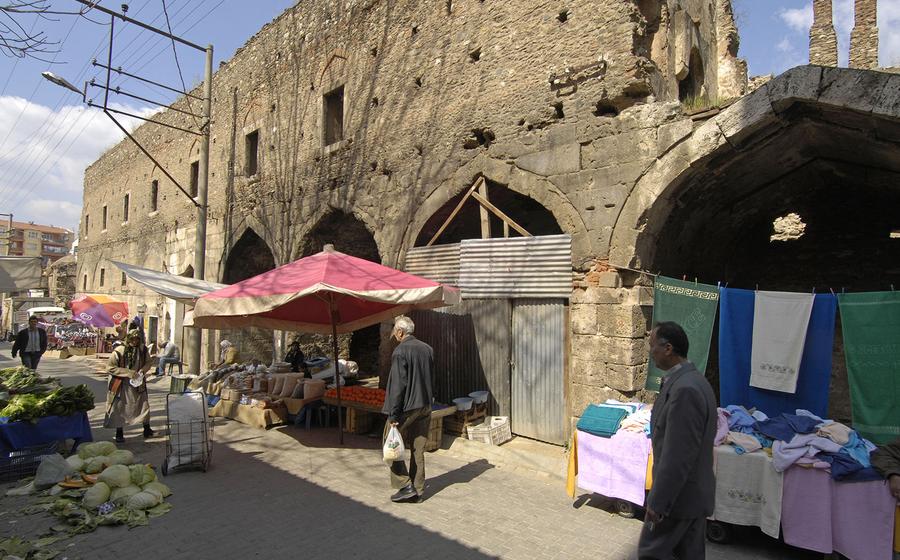
Kusadasi Castle Walls
- Kusadasi Castle Walls: An Overview
- Exploring the Castle Walls
- The Byzantine Period
- The Greek Occupation
- The Liberation of Kusadasi
- Restoration and Preservation
- Panoramic Views
- Cultural Events and Festivals:
- Shopping and Souvenirs:
- Nearby Attractions
- Accessibility and Facilities
- Insider Tip:
Kusadasi Castle Walls: An Overview
The Kusadasi Castle Walls, a testament to the city's rich history, stand as a symbol of resilience and architectural prowess. Built in the 15th century by the Byzantines, the walls were further fortified by the Ottomans and served as a crucial defensive structure against invaders. Strategically positioned on a peninsula overlooking the Aegean Sea, the castle's massive walls and towers once protected the city from naval attacks and land-based assaults. Constructed using local stone and featuring intricate masonry, the castle walls showcase the ingenuity and skill of the builders. Their enduring presence bears witness to the strategic importance of Kusadasi throughout history.
Exploring the Castle Walls
Exploring the Kusadasi Castle Walls promises an immersive journey through history and breathtaking vistas. Follow the well-marked paths that wind along the ramparts, allowing you to delve into the castle's rich past and capture stunning photographs of the surrounding landscapes.
Begin your exploration from the main entrance, where you'll encounter the impressive Byzantine gate. As you ascend the walls, you'll be rewarded with panoramic views of the city, the Aegean Sea, and the distant mountains. Take your time to admire the intricate stonework and architectural details that speak to the skill of the ancient builders.
Along the way, you'll encounter several notable landmarks, including the restored Byzantine tower, which now houses a small museum showcasing artifacts from the castle's past. Don't miss the opportunity to climb to the top of the tower for even more breathtaking views.
For a deeper understanding of the castle's history and significance, consider joining a guided tour. These tours, led by knowledgeable local guides, provide fascinating insights into the castle's role in defending the city from invaders and the various civilizations that have left their mark on its walls.
Whether you choose to explore independently or with a guide, remember to bring your camera to capture the stunning beauty of the castle and its surroundings. The golden hues of sunrise and sunset cast a magical glow on the ancient stones, creating unforgettable photographic opportunities.
The Byzantine Period
Kusadasi's history is intricately linked to the Byzantine Empire, which ruled the region for nearly a millennium. During this period, the castle walls underwent significant development and played a crucial role in defending the city against invaders. The Byzantines, renowned for their architectural prowess, constructed formidable fortifications to protect their territories.
The Byzantine walls of Kusadasi were built using a combination of stone and brick, featuring robust towers and imposing gates. These fortifications effectively shielded the city from attacks by sea and land. The walls' strategic positioning allowed Byzantine soldiers to monitor enemy movements and respond swiftly to threats.
One notable landmark from this era is the Byzantine cistern, located within the castle grounds. This underground reservoir provided a vital water supply to the city's inhabitants during times of siege or drought. The cistern's construction demonstrates the Byzantines' foresight and engineering skills.
A particularly compelling anecdote from the Byzantine era involves a daring escape from the castle. During an Arab siege, a group of Byzantine soldiers disguised themselves as Arab merchants and managed to sneak out of the city through a secret passageway. This audacious maneuver allowed them to seek reinforcements and ultimately repel the invaders.
The Greek Occupation
In 1919, the Greek forces, taking advantage of the chaos and turmoil of the post-Ottoman era, occupied Kusadasi, along with other parts of Western Anatolia. The Greek occupation was met with strong resistance from the local population, who resented the foreign presence and sought to regain their independence.
The castle walls, a symbol of Kusadasi's resilience and fortitude, played a crucial role during the occupation. The Greeks, recognizing the strategic importance of the castle, fortified it further and used it as a military base to suppress local resistance.
Despite the Greek occupation, the people of Kusadasi remained steadfast in their determination to liberate their city. They formed underground resistance groups, conducted sabotage operations, and worked tirelessly to undermine the Greek rule.
In 1922, the Turkish forces, led by Mustafa Kemal Ataturk, launched a successful counteroffensive against the Greeks, culminating in the liberation of Kusadasi and the expulsion of the Greek forces from Anatolia. The castle walls, bearing the scars of battle, stood as a testament to the resilience and unwavering spirit of the Kusadasi people.
The Liberation of Kusadasi
The liberation of Kusadasi from Greek occupation in 1922 stands as a testament to the resilience and unwavering spirit of the Turkish people. After years of foreign rule, the city's inhabitants rose up in defiance, determined to reclaim their freedom. The castle walls, which had once served as a symbol of oppression, became a rallying point for the resistance.
Under the command of Mustafa Kemal Atatürk, the Turkish forces launched a daring offensive against the Greek occupiers. The battle for Kusadasi was fierce, with both sides fighting valiantly for control of the city. The castle walls became a focal point of the conflict, as the Turkish soldiers fought tooth and nail to dislodge the Greek troops from their stronghold.
After days of intense fighting, the Turkish forces finally breached the castle walls and drove out the Greek occupiers. The liberation of Kusadasi was met with jubilation and relief by the city's inhabitants. The castle walls, once a symbol of oppression, were now transformed into a symbol of freedom and independence.
To this day, the liberation of Kusadasi is commemorated with great pride and enthusiasm. Every year, the city holds a special festival to mark the anniversary of this momentous event. The festival features traditional Turkish music, dance, and food, as well as historical reenactments and storytelling sessions. It is a time for the people of Kusadasi to come together and celebrate their hard-won freedom.
Restoration and Preservation
Efforts to restore and preserve the Kusadasi Castle Walls have been ongoing for several decades. These efforts have involved careful planning, meticulous restoration techniques, and collaboration between historians, architects, and conservationists. The primary goal of the restoration process has been to maintain the authenticity and historical integrity of the walls while ensuring their structural stability and safety for visitors.
Challenges Faced: The restoration process has encountered several challenges, including the need to balance preservation with necessary repairs, the sourcing of authentic materials, and addressing the effects of natural weathering and erosion. Additionally, the castle's location in a seismically active region requires special considerations for earthquake-proofing and ensuring the stability of the walls during potential tremors.
Importance of Preservation: Preserving the Kusadasi Castle Walls is of utmost importance for several reasons. First, the walls are a tangible reminder of the city's rich history and cultural heritage. They represent centuries of architectural innovation, military strategy, and the resilience of the people of Kusadasi. Second, the walls are a major tourist attraction, drawing visitors from around the world who come to admire their grandeur and learn about their historical significance. Preserving the walls ensures that future generations can continue to appreciate this unique heritage site.
Success Stories: The restoration efforts have achieved significant success in preserving the Kusadasi Castle Walls. Through careful restoration techniques, the original features and architectural details of the walls have been meticulously preserved, ensuring their authenticity. Additionally, the walls have been reinforced and stabilized to withstand the effects of time and natural disasters. The success of these efforts is evident in the restored sections of the walls, which have regained their original strength and beauty, standing as a testament to the dedication and expertise of the restoration team.
Panoramic Views
As you explore the castle walls, prepare to be mesmerized by the breathtaking views that unfold before your eyes. The castle's elevated position offers unparalleled panoramas of the city, the Aegean Sea, and the picturesque surrounding landscape. From the ramparts, you can gaze out over the terracotta-roofed houses of Kusadasi, stretching towards the shimmering turquoise waters of the Aegean. The coastline unfolds like a tapestry, adorned with inviting sandy beaches and secluded coves.
Capture the essence of this stunning scenery with your camera, as the castle walls provide endless opportunities for photography enthusiasts. Whether you're a seasoned professional or a casual shutterbug, you'll find yourself spoilt for choice when it comes to capturing postcard-perfect shots. The golden hues of sunset cast a magical glow over the landscape, creating an unforgettable spectacle that will leave you in awe.
Find your perfect spot to soak in the panoramic vistas. Perched atop the battlements, you'll feel like a sentinel of the past, with the world at your feet. Whether you choose to bask in the warmth of the sun or marvel at the starlit sky, the castle walls offer a sanctuary for contemplation and wonder.
Cultural Events and Festivals:
The Kusadasi Castle Walls come alive with cultural events, festivals, and performances throughout the year. These events showcase the rich heritage and vibrant traditions of Turkey. Visitors can experience traditional Turkish music, captivating dance performances, and mesmerizing art exhibitions within the castle's historic setting.
One of the highlights is the annual Kusadasi International Music Festival, which brings together renowned musicians from around the world to perform on the castle's stage. The festival fills the air with melodies from classical to contemporary genres, creating a magical atmosphere under the stars.
History buffs can delve into the past during historical reenactments that bring to life significant events that shaped the castle's history. Storytellers captivate audiences with tales of bravery, romance, and intrigue, while traditional Turkish shadow puppet shows entertain both young and old.
These cultural events and festivals offer a unique opportunity to immerse oneself in Turkish culture and traditions. Visitors can mingle with locals, savor delicious Turkish cuisine, and create lasting memories against the backdrop of the ancient castle walls.
Shopping and Souvenirs:
Strolling along the cobblestone streets near the Kusadasi Castle Walls, visitors will find a treasure trove of shopping opportunities. Local artisans and vendors display their handcrafted souvenirs, traditional Turkish products, and unique keepsakes. From intricate ceramics and colorful textiles to aromatic spices and delectable sweets, there's something to satisfy every taste and budget.
Tips for Finding Unique and Authentic Items:
- Venture beyond the main tourist shops to explore the smaller boutiques and ateliers tucked away in the charming alleys.
- Engage with the local artisans and learn about their techniques and inspirations.
- Don't be afraid to bargain, as it's a customary part of the shopping experience in Turkey.
- Look for items that are handmade and locally produced to ensure authenticity.
Must-Try Dishes and Local Eateries:
- Indulge in freshly caught seafood delicacies at one of the many charming restaurants overlooking the Aegean Sea.
- Savor the flavors of traditional Turkish cuisine at a local eatery, where you can experience the warmth and hospitality of Turkish culture.
- Don't miss the opportunity to try Turkish delight, a sweet treat made from sugar, starch, and nuts, available in a variety of flavors.
Personal Recommendations:
- For a unique souvenir, consider purchasing a hand-painted ceramic plate or bowl adorned with intricate Ottoman motifs.
- If you're looking for a taste of local cuisine, try the "kusadasi böreği," a flaky pastry filled with cheese and spinach, at one of the traditional bakeries near the castle walls.
- To capture the essence of the Aegean Sea, purchase a bottle of locally produced olive oil, renowned for its rich flavor and aroma.
Nearby Attractions
Beyond the captivating allure of the Kusadasi Castle Walls, a myriad of other historical gems and cultural treasures await exploration in the vicinity. Embark on a journey through time as you visit the ancient city of Ephesus, a UNESCO World Heritage Site that once served as a thriving center of commerce and culture. Marvel at the remarkably preserved ruins, including the awe-inspiring Library of Celsus, the imposing Temple of Artemis, and the spectacular Great Theater.
Venture further to discover the intriguing Ephesus Museum, which houses an exceptional collection of artifacts unearthed from the ancient city. Admire the exquisite sculptures, intricate mosaics, and everyday objects that shed light on the rich history and vibrant life of Ephesus.
Immerse yourself in the vibrant local culture at the Kusadasi Bazaar, a bustling marketplace where you can haggle for unique souvenirs, savor delectable Turkish delights, and experience the infectious energy of traditional Turkish life.
For a tranquil escape, seek solace in the serene Güvercinada Island, a small islet just off the coast of Kusadasi. bask in the tranquility of this natural paradise, stroll along the picturesque shoreline, and soak up the breathtaking views of the Aegean Sea.
Plan a day trip to the charming village of Sirince, nestled amidst picturesque vineyards and olive groves. Explore its narrow cobblestone streets, admire the charming Ottoman-era houses, and indulge in a delightful wine tasting experience.
Embrace the opportunity to venture beyond the castle walls and immerse yourself in the rich tapestry of history, culture, and natural beauty that surrounds this captivating destination.
Accessibility and Facilities
The Kusadasi Castle Walls are generally accessible to visitors, offering a range of facilities to enhance your exploration. For those with limited mobility, designated ramps and pathways allow for easy navigation throughout the site. Restrooms are conveniently located at various points along the walls, ensuring comfort and convenience. To quench your thirst, drinking water fountains are strategically placed to keep you hydrated during your visit.
Safety is a top priority, and the castle walls are well-maintained to ensure a secure environment for all visitors. Clearly marked signs and guidelines provide direction and information, helping you make the most of your exploration. Responsible behavior is encouraged, including respecting the historical significance of the site and avoiding actions that may damage or disturb the castle's संरचना.
To fully immerse yourself in the history and stories of the castle walls, consider joining a guided tour. Knowledgeable guides can provide insights and anecdotes, bringing the castle's past to life. Alternatively, self-guided exploration allows you to set your own pace and focus on specific aspects that capture your interest.
Whether you choose to wander alone or with a group, remember to wear comfortable shoes suitable for walking on uneven surfaces. The castle walls offer a unique opportunity to step back in time and experience the rich history of Kusadasi. Embrace the journey, soak in the breathtaking views, and create lasting memories as you explore this iconic landmark.
Insider Tip:
Unveiling the Hidden Gem of the Castle Tunnels:
While exploring the castle walls, don't miss the opportunity to venture into the hidden tunnels that lie beneath the fortress. These tunnels, once used for secret passages and military purposes, offer a unique and thrilling experience. Embark on a journey through history as you navigate the dimly lit corridors, discovering forgotten chambers and unraveling the secrets of the castle's past. Remember to bring a flashlight or use your phone's torch to illuminate your path through this subterranean labyrinth.
Secret Sunset Spot for Panoramic Views:
For a truly magical experience, head to the lesser-known westernmost corner of the castle walls just before sunset. Here, you'll find a secluded spot that offers breathtaking panoramic views of the Aegean Sea, the Greek island of Samos, and the city of Kusadasi bathed in golden hues. As the sun dips below the horizon, the sky transforms into a canvas of vibrant colors, creating a mesmerizing spectacle that will leave you in awe. Don't forget your camera to capture this unforgettable moment.
Avoid the Crowds and Capture the Castle's Essence:
To fully appreciate the tranquility and beauty of the castle walls, plan your visit for the early morning or late afternoon when the crowds have dispersed. This will allow you to immerse yourself in the atmosphere of the place, soak in the stunning views, and capture breathtaking photographs without the distraction of throngs of tourists. Embrace the serenity of the castle as you wander along its ramparts, reveling in the peace and solitude that enhance the experience.





